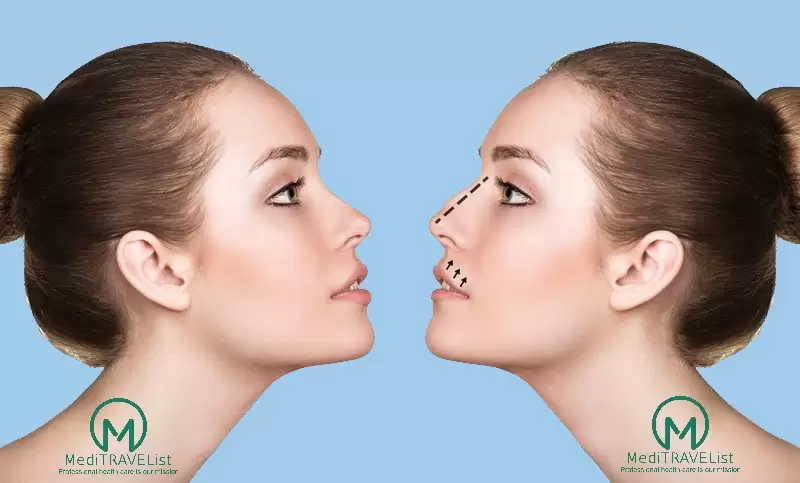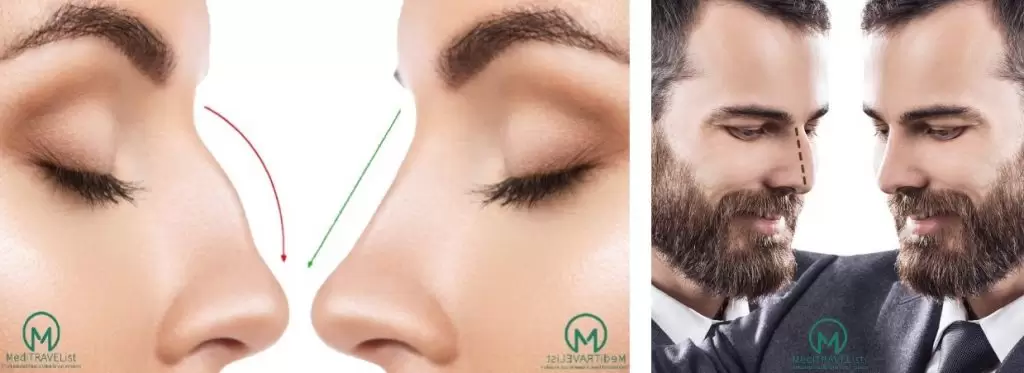
Rhinoplasty - Nose Job Operation Details Istanbul Turkey |
||
|---|---|---|
 Accommodation 7-8 Days |
 Hospital Stay 1 Day |
 Operation Duration 1-3 Hours |
 Anaesthesia general anesthesia |
 Recovery Duration 7-10 Months |
 Follow Up Visit 7th Day |
Click Here For More Information |
||
What is Rhinoplasty?
Surgical intervention performed to alter the shape of the nose is called rhinoplasty or nasal aesthetic surgery. Rhinoplasty can be performed to change the appearance of the nose, improve breathing, or achieve both purposes. The lower part of the nose is composed of cartilage, while the upper part is made of bone, and rhinoplasty surgery can involve altering the nose bone, cartilage, skin layer, or all three.
Why is Rhinoplasty Performed?
Rhinoplasty is generally performed to enhance the aesthetic appearance of the nose and its harmony with facial features for individuals dissatisfied with their nose’s appearance. Additionally, specific situations that may necessitate rhinoplasty include:
– Damage or functional issues in the appearance of the nose due to accidents or trauma.
– Incompatibility of nose contours with other facial elements.
– A prominent or wide nasal bridge.
– A wide, crooked, or protruding nasal tip.
– Excessively narrow or wide nostrils.
If a patient has undergone rhinoplasty one or more times before but requires improvement in the appearance and function of the nose, revision rhinoplasty becomes relevant. Revision rhinoplasty is performed with the goal of correcting nasal deformities while preserving maximal nasal function.
Who is a Candidate for Rhinoplasty?
The decision for rhinoplasty surgery suitability is made on an individual basis, taking into account various factors during the decision-making process. The person undergoing rhinoplasty should have completed nasal development, meaning the nose has reached adult dimensions. Additionally, the patient’s overall health should be suitable for surgery, and their expectations regarding the postoperative appearance should be realistic. Individuals who desire a more aesthetically pleasing nose in harmony with facial features and meet these criteria may be candidates for rhinoplasty surgery.
Types of Rhinoplasty:
Rhinoplasty can be performed using the open or closed technique, determined based on the patient’s nasal structure and the specific issue to be addressed.
Closed Rhinoplasty:
Closed rhinoplasty, also known as scarless rhinoplasty, involves making incisions inside the nostrils to access the nasal septum. There are no external incisions or stitches on the outer part of the nose. Closed rhinoplasty is typically suitable for individuals undergoing their first rhinoplasty surgery, requiring minimal changes to the nasal septum, and not needing intervention in the nasal tip or cartilage.
Open Rhinoplasty:
Open rhinoplasty is preferred for individuals with deformities or asymmetry in the nasal tip, those undergoing simultaneous septoplasty, or those who have previously had rhinoplasty surgery. A small incision is made on the soft tissue known as the “columella” between the nostrils, allowing the surgeon direct access to the underlying bone and cartilage structures that form the nasal tip.
Difference Between Open Rhinoplasty and Closed Rhinoplasty:
In closed rhinoplasty, incisions are made inside the nostrils, and microsurgical cameras are used to visualize the inside of the nose. However, the surgeon’s field of view is more limited compared to open rhinoplasty. Due to not opening the nasal skin and soft tissues, not cutting or bleeding of ligaments, the healing process is shorter than open rhinoplasty.
In open rhinoplasty, the surgery is performed directly under direct vision, allowing for precise symmetry and the placement of necessary cartilage supports. This reduces the risks of postoperative changes in the nose tip, drooping, or septum deviation. Although there may be a scar due to the incision made on the columella, it is not usually significant enough to cause discomfort for the patients.
Surgical Process:
Rhinoplasty is performed using the chosen open or closed technique based on the patient’s nasal issues, structural features, and the surgeon’s preferences. Generally, rhinoplasty is performed under general anesthesia. Local anesthesia may be used in some minor procedures, depending on the surgeon’s preference.
In open rhinoplasty, an incision is made on the columella, and access is gained to the cartilage and bone tissue beneath the nose tissue. The planned procedure is completed, and the surgery is concluded. Swelling and bruising may be more pronounced in open rhinoplasty compared to closed rhinoplasty, and the recovery period may be longer.
In closed rhinoplasty, incisions are made inside the nostrils, and the surgery is performed using microsurgical cameras. The healing process is generally faster, with less swelling and bruising.
Recovery Process:
After the anesthesia wears off, some discomfort may be felt, and the prescribed pain relievers and other medications should be used regularly during this period. Depending on the chosen technique and the extent of the procedure, bruising and swelling may occur around the eyes, nose, and specific areas of the face. To minimize the risk of bleeding, it is advisable to use a high pillow in the early postoperative period, avoid drawing water into the nose for the first 15 days, and refrain from blowing the nose.
Glasses should not be worn during the doctor-specified period after rhinoplasty. Patients should avoid direct exposure to sunlight during this time. Light exercises can typically be started a week after the surgery, depending on the specific approval of the patient.
Risks:
Like any surgical procedure, rhinoplasty has certain risks, including anesthesia-related risks, the development of infections, changes in skin sensation, scarring, and difficulty breathing. However, when rhinoplasty is performed by an expert and experienced surgeon with individualized planning, these risks can be minimized.
Age Limitations:
Rhinoplasty surgery is suitable for individuals whose nasal bone and cartilage tissues have completed development. Since this generally occurs around the age of 16 for females and 18 for males, rhinoplasty is not recommended for those under these ages. However, the essential criterion is the completion of the development of bone and cartilage tissue, so the decision for surgery is made based on an individual evaluation.
There is no upper age limit for rhinoplasty, and the determining factor is the decision made by the surgeon based on individual assessments.
Characteristics of Individuals Suitable or Unsuitable for Rhinoplasty:
Individuals considering rhinoplasty should be in good overall health without contraindications for surgery. The development of nasal bone and cartilage tissues should be completed. Additionally, there should be a noticeable nasal shape deformity.
Unsuitable characteristics for rhinoplasty include various health problems, incomplete adolescence, and unrealistic expectations regarding surgery outcomes.
Desired Nose in Rhinoplasty:
In rhinoplasty, the goal is to achieve a nose that is harmonious with other facial features, balanced, natural-looking, does not adversely affect nasal functionality, and is suitable for the individual’s age, gender, and preferences. Since each person’s face is unique, the definition of an ideal nose can vary widely.

Rhinoplasty (Nose Job) in İstanbul Turkey Before&After
Working Hours
- Monday: 09:00 – 18:00
- Tuesday: 09:00 – 18:00
- Wednesday: 09:00 – 18:00
- Thursday: 09:00 – 18:00
- Friday: 09:00 – 18:00
- Saturday: 09:00 – 18:00
- Sunday: Closed
